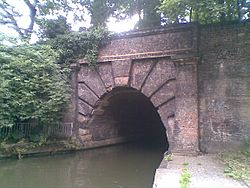Islington Tunnel facts for kids
 |
|
| Eastern portal | |
| Overview | |
|---|---|
| Location | Islington, London, England |
| Coordinates | 51°32′2.8″N 0°6′31.18″W / 51.534111°N 0.1086611°W |
| OS grid reference | TQ312833 |
| Status | Open |
| Waterway | Regent's Canal |
| Start | 51°31′59.37″N 0°6′9.67″W / 51.5331583°N 0.1026861°W |
| End | 51°32′5.12″N 0°6′54.07″W / 51.5347556°N 0.1150194°W |
| Operation | |
| Owner | Canal & River Trust |
| Technical | |
| Design engineer | James Morgan |
| Length | 960 yards (878 m) |
| Towpath | No |
| Boat-passable | Yes |
The Islington Tunnel is a long tunnel for boats in London. It carries the Regent's Canal for about 960 yards (878 meters) right under the area of Islington. This tunnel is the longest of its kind in London. It opened in 1818 for small boats and barges. Since there's no path for walking next to the canal inside the tunnel, special markers on the streets above help people follow the route. Other tunnels on the Regent's Canal, like Eyre's and Maida Hill, are much shorter.
Contents
History of the Islington Tunnel
The Islington Tunnel first opened in 1818. It was designed and built by an engineer named James Morgan.
Planning the Canal
The idea for the Regent's Canal became official on 13 July 1812. This happened when a special law, called an Act of Parliament, was passed. Just a month later, James Morgan was chosen to be the main engineer for the whole project. He had already drawn up plans to help get the law approved.
At first, Morgan didn't have much experience building big engineering projects. So, the company decided to hold a competition. They wanted other engineers to design the locks and tunnels. Famous engineer William Jessop was one of the judges. Even though people sent in their designs, none were chosen. In December, Morgan became fully in charge of everything.
Building Challenges and Funding
Building the canal was very expensive. The company often didn't have enough money. They had only raised about £254,100, but the project was expected to cost £400,000. As work continued, it became clear they needed even more money.
The first part of the canal opened in 1816. This section went from Paddington Basin to Camden. Some work had started on the tunnel, but then construction stopped. There was no more money left. Another Act of Parliament allowed the company to try and raise more funds. However, they still couldn't find any investors.
Government Help for the Project
Luckily, a solution appeared. The canal company's former chairman met with a group helping poor people. They talked about the government lending money to the project. This would not only finish the canal but also give jobs to many people who didn't have work.
So, the Exchequer Bill Loan Commission was created in 1817. This group could give loans to public projects that would create jobs. Another famous engineer, Thomas Telford, checked the unfinished canal and tunnel. The Commissioners then promised a large loan of £200,000. But the canal company had to raise £100,000 themselves first. They managed to do this, and work on the tunnel started again in December 1817. The entire Regent's Canal finally opened on 1 August 1820.
The Tunnel Builder
The job of building the Islington Tunnel went to Daniel Pritchard. He was an experienced tunnel builder. He had previously built tunnels for the Grand Union Canal. These included the Husbands Bosworth Tunnel (1170 yards long) and the Crick Tunnel (1528 yards long). He finished these even though the ground was difficult. After building the 960-yard Islington Tunnel and the nearby Maida Hill Tunnel, he became a specialist in tunnel construction. He went on to build other important tunnels, like the Strood Tunnel and the second Harecastle Tunnel.
Moving Boats Through the Tunnel
The Islington Tunnel does not have a towpath. This means horses could not pull boats through it. Originally, people called "leggers" had to move the barges. They would lie on top of the boat and "walk" along the tunnel walls or roof with their feet to push the boat through.
In 1826, things got easier. A steam tug was introduced. This tug pulled boats through the tunnel using a guiding chain in the water. This system was used until the 1930s. Then, a diesel engine replaced the steam tug. Today, most boats have their own engines, so the old tug system is no longer needed.
Following the Route Above Ground
Since there is no towpath inside the Islington Tunnel, walkers and cyclists cannot go through it. However, if you want to follow the canal's path above ground, there are special waymarkers. These markers are set into the pavements.
Starting from the eastern end of the tunnel, you can follow the trail:
- Walk up Duncan Street.
- Turn left onto Islington High Street.
- Cross High Street near Angel Underground Station.
- Go up Liverpool Road.
- Turn left into Chapel Market.
- At the end of Chapel Market, turn right into Penton Street.
- Finally, turn left into Maygood Street.
- At the end of Maygood Street, you'll pass through a small residential area.
- The trail ends in Muriel Street, where you can get back onto the canal's towpath.
Gallery





